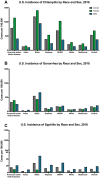Laboratory Perspective on Racial Disparities in Sexually Transmitted Infections
- PMID: 33247907
- PMCID: PMC7799034
- DOI: 10.1093/jalm/jfaa163
Laboratory Perspective on Racial Disparities in Sexually Transmitted Infections
Abstract
Background: Rates of sexually transmitted infections (STI) have risen steadily in recent years, and racial and ethnic minorities have borne the disproportionate burden of STI increases in the United States. Historical inequities and social determinants of health are significant contributors to observed disparities and affect access to diagnostic testing for STI.
Content: Public health systems rely heavily on laboratory medicine professionals for diagnosis and reporting of STI. Therefore, it is imperative that clinicians and laboratory professionals be familiar with issues underlying disparities in STI incidence and barriers to reliable diagnostic testing. In this mini-review, we will summarize contributors to racial/ethnic disparity in STI, highlight current epidemiologic trends for gonorrhea, chlamydia, and syphilis, discuss policy issues that affect laboratory and public health funding, and identify specific analytic challenges for diagnostic laboratories.
Summary: Racial and ethnic disparities in STI in the US are striking and are due to complex interactions of myriad social determinants of health. Budgetary cuts for laboratory and public health services and competition for resources during the COVID-19 pandemic are major challenges. Laboratory professionals must be aware of these underlying issues and work to maximize efforts to ensure equitable access to diagnostic STI testing for all persons, particularly those most disproportionately burdened by STI.
Keywords: Health disparities; chlamydia; gonorrhea; sexually transmitted; syphilis.
© American Association for Clinical Chemistry 2020. All rights reserved. For permissions, please contact: journals.permissions@oup.com.
Figures

Similar articles
-
Health Center Testing for SARS-CoV-2 During the COVID-19 Pandemic - United States, June 5-October 2, 2020.MMWR Morb Mortal Wkly Rep. 2020 Dec 18;69(50):1895-1901. doi: 10.15585/mmwr.mm6950a3. MMWR Morb Mortal Wkly Rep. 2020. PMID: 33332299 Free PMC article.
-
Accuracy in Measuring Racial Disparities during the COVID-19 Pandemic Needs Improvement.J Appl Lab Med. 2021 Jan 12;6(1):310-313. doi: 10.1093/jalm/jfaa212. J Appl Lab Med. 2021. PMID: 33300994 Free PMC article. No abstract available.
-
Racial and Ethnic Disparities in COVID-19 Incidence by Age, Sex, and Period Among Persons Aged <25 Years - 16 U.S. Jurisdictions, January 1-December 31, 2020.MMWR Morb Mortal Wkly Rep. 2021 Mar 19;70(11):382-388. doi: 10.15585/mmwr.mm7011e1. MMWR Morb Mortal Wkly Rep. 2021. PMID: 33735165 Free PMC article.
-
On Answering the Call to Action For COVID-19: Continuing a Bold Legacy of Health Advocacy.J Natl Med Assoc. 2020 Jun;112(3):324-328. doi: 10.1016/j.jnma.2020.06.010. Epub 2020 Jun 5. J Natl Med Assoc. 2020. PMID: 32563686 Free PMC article. Review.
-
Sexually Transmitted Infections Prevalence in the United States and the Relationship to Social Determinants of Health.Nurs Clin North Am. 2020 Sep;55(3):283-293. doi: 10.1016/j.cnur.2020.05.001. Epub 2020 Jul 15. Nurs Clin North Am. 2020. PMID: 32762850 Review.
Cited by
-
Older Adults' Socio-Demographic Determinants of Health Related to Promoting Health and Getting Preventive Health Care in Southern United States: A Secondary Analysis of a Survey Project Dataset.Nurs Rep. 2021 Mar;11(1):120-132. doi: 10.3390/nursrep11010012. Epub 2021 Feb 15. Nurs Rep. 2021. PMID: 33791080 Free PMC article.
References
-
- Keppel KG. Ten largest racial and ethnic health disparities in the United States based on healthy people 2010 objectives. Am J Epidemiol 2007;166:97–103. - PubMed
-
- Centers for Disease Control and Prevention. Sexually transmitted disease surveillance 2018. U.S. Department of Health and Human Services, 2019;1-159.
-
- Centers for Disease Control and Prevention. HIV Surveillance Report 2018 (Preliminary). 2019;30:129.
-
- Laumann EO, Gagnon JH, Michael RT, Michaels S. The social organization of sexuality: sexual practices in the United States. Chicago: The University of Chicago Press; 1994. p. 718.
-
- Singer M. A dose of drugs, a touch of violence, a case of AIDS: Conceptualizing the Sava syndemic. Free Inquiry Creative Sociol 1996;24:99–110.
Publication types
MeSH terms
Grants and funding
LinkOut - more resources
Full Text Sources
Medical

